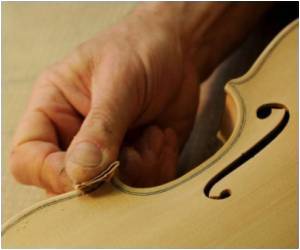
Low density, high speed of sound and a high modulus of elasticity - these qualities are essential for ideal violin tone wood. In the late 17th and early 18th century the famous violin maker Antonio Stradivari used a special wood that had grown in the cold period between 1645 and 1715.
In the long winters and the cool summers, the wood grew especially slowly and evenly, creating low density and a high modulus of elasticity. Until now, modern violin makers could only dream of wood with such tonal qualities.
The new treatment introduced by Professor Francis W. M. R. Schwarze (Empa, Swiss Federal Laboratories for Materials Science and Technology, St. Gallen, Switzerland) could soon make similarly good wood available for violin making.
He discovered two species of fungi (Physisporinus vitreus and Xylaria longipes), which decay Norway spruce and sycamore - the two important kinds of wood used for violin making - to such an extent that their tonal quality is improved.
"Normally fungi reduce the density of the wood, but at the same time they unfortunately reduce the speed with which the sound waves travel through the wood," the researcher explained.
Advertisement
Even the modulus of elasticity is not compromised; the wood remains just as resistant to strain as before the fungal treatment - an important criterion for violin making. Before the wood is further processed to a violin, it is treated with ethylene oxide gas.
Advertisement
That ensures that fungal growth in the wood of the violin is completely stopped.
Together with the violin makers Martin Schleske and Michael Rhonheimer, Professor Schwarze developed violins made of mycowood (wood treated with wood decay fungi).
In 2009 the violins were played in a blind, behind-the-curtain test versus a genuine Stradivarius from 1711. All the violins were played by the British violinist Matthew Trusler.
The result was surprising for all participants: Both the jury of experts and the majority of the audience thought that the mycowood violin that Schwarze had treated with fungi for nine months was the actual Strad.
Currently Professor Schwarze is working on an interdisciplinary project to develop a quality-controlled treatment for violin wood, with successful, reliable and reproducible results.
Until 2014, within the scope of the project that is funded by the Swiss Walter Fischli Foundation, 30 additional violins shall be made from fungally-treated wood.
Schwarze explained what opportunities this project can lead to: "The successful implementation of biotechnological methods for treating soundboard wood could in the future give young musicians the opportunity to play on a violin with the sound quality of an expensive - and for most musicians unaffordable - Stradivarius."
Schwarze reported his research at the 1st ECRC "Franz-Volhard" Symposium of the Max Delbruck Center for Molecular Medicine (MDC) and Charite - Universitatsmedizin on September 7, 2012 in Berlin-Buch.
Source-ANI











